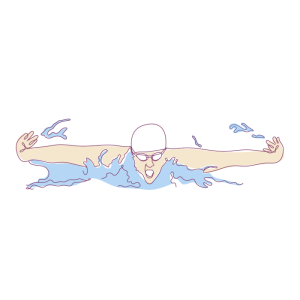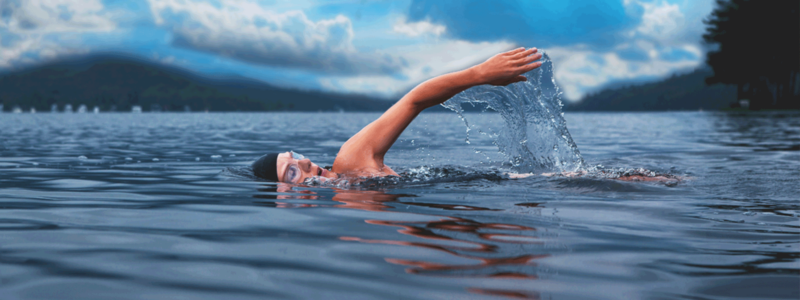Training for a triathlon takes hard work, time and commitment to get your body ready for the challenge. Most beginners will start off with a sprint triathlon, which is typically a 750m swim, a 20k bike ride, and a 5k run. If you’re reasonably fit and healthy, building up to the fitness and strength to be able to complete this will take around 12 weeks. This should give you enough time to condition your tendons and ligaments, and build your endurance to the point where you’ll enjoy taking part in the race.
Throughout the 12 weeks you should try to fit between 2.5 and 4 hours of training in per week. This should include a mix of swimming, cycling and running. In a sprint triathlon, the average participant spends about a 20% of the total race swimming, 50% cycling, and about 30% running. You should try and generally match these distributions in your training. Start by training 3 times a week, working on each of the disciplines. Slowly increase this to 4/5 times a week by introducing a bike to run workout, which will help you get used to running after cycling, and open water training.
Here are a few tips to follow for each discipline.
Training for the swimming stage

Work on your technique
Swimming is the part that most competitors struggle with the most. If you haven’t spent much time in the pool or had much training in the past, it’s highly recommended to have a few sessions with a swimming coach. Perfecting stroke technique is so precise that an expert’s advice can make all the difference. Professional triathletes continue to constantly work on their technique, so it’s a good place to start.
If coaching isn’t an option for you, then you can also try asking a friend to film you swimming to see if you can spot areas you can work on. Watching a recording will give you a clearer, unbiased view and highlight any areas that you can improve. You’d be surprised how much you can spot from watching a short clip!

Join a training group
Joining a group to train with is a really good idea and will help with your technique, as well as your motivation and encouragement. Consider joining a Tri Club or a local training group that offers both regular training and social events too.
If group training isn’t for you, you might consider training with a friend who will keep you motivated, spur you on, and engage your competitive side.

Train in open water
While most of your training will take place in the pool, if your triathlon swim is in open water it’s a good idea to try and get a few practices outside complete before the race. Try and find a lake you can practice in occasionally – this will give you an opportunity to try out your wetsuit and get used to how it feels to swim in one. You can also practice “sighting”, or lifting your head up to make sure you’re on the right track.

Cross Train
Cross training with yoga or Pilates will improve mobility, develop your core and help your breathing technique. Try and mix in a holistic class like this once a week, or commit some time to stretching and improving your balance. You’ll notice the new techniques you learn will have secondary benefits, helping with your swimming too!
Training for the cycling stage

Fit your bike
Before you start training, make sure your bike is professionally fitted to your body. It’s important to make sure you’ve got the right fit to avoid injuries. Head down to your local bike shop who’ll be able to get you set up correctly.

Ride, a lot!
When you start your training try and get in as much bike time as possible. Because the bike is where you’ll spend the majority of the race, ensuring your comfortable and strong in this stage could help you shave minutes off your time.
Cycling is a great way to increase your fitness, and all of this fitness will be translated into your running too. By spending more time cycling than running, you’ll be putting less pressure on your joints as well. Start with shorter, easier rides during the week and then ride longer distances at the weekend.
Training for the running stage
Running should be where you spend your least amount of training time. Like cycling, stick to shorter, quicker runs during the week, and build endurance at the weekend.
You should try a few short runs right off the long bike ride, to give yourself (and your legs!) some practice on how to transition. This will help you get used to the switch, and stop your legs feeling quite so heavy. The first time you try this can be quite a shock, so don’t panic!

Rest
As with any sort of training, taking rest days is really important. When you start, create a practical and manageable training plan, and stick to it wherever possible. Any sudden and substantial increases in training volume or intensity will impact your body negatively as it won’t have time to adapt to the stress. Always increase your training gradually from one week to the next and you’ll avoid unnecessary injury.
Whichever stage you need help with, your local David Lloyd Club will be able to offer training advice from one of its expert coaches. Find your local club.
The gear

Triathlon requires quite a lot of equipment, so be prepared for this before you commit. It doesn’t need to be expensive though, so shop around the find the best deals. Here’s a list of what you’ll need:
• A swim suit, goggles (make sure they fit well to avoid leaking), and a swimming cap if you have longer hair.
Tip: To avoid lens fogging in your goggles, add a drop of baby shampoo to the lenses before each use.
• A bicycle that fits you and is in good working order. This will be a road bike ideally, if not, then a mountain bike or a hybrid. Whilst a mountain bike will certainly do the job, it won’t go as fast. Replacing the tires with smooth, thinner ones will make you speedier.
Tip: Your local bike shop will be able to get your chosen bike race-ready. They’ll check the drivetrain is clean and lubricated, the fit is adjusted and any worn parts are replaced. It’s also a great idea to get some basic maintenance tips whilst you’re there too.
• It’s worth investing in a really decent pair of cycling shorts – you’ll be thankful for the padding half way through your cycle stage!
• A helmet, cycling glasses, tire pump, spare tube and a wrench set for adjusting bolts.
• You can buy clipless pedals and cycling shoes, but these are not essential by any means.
• A water bottle for use on your longer bike rides.
• A good pair of running shoes.
Practicing transitions
Transitions count in your overall race time so they are worth practicing. T1 is the change between swimming and cycling, and T2 is when you come off the bike into your run.
During training, you can practice by setting up your transition area like you would on race day. Lay out a towel next to your bike (which will be on a rack), and set up all your gear, include your helmet, shoes, socks, sunglasses, bike gloves, race number belt, and another towel in case you need it.
If you are able to do a practice open-water swim, this is the ideal time to try a practice transition. Come out of the water, run to your transition area, get out of your wetsuit, and put on all your bike gear. Finally try a bike-to-run transition. By practicing these moves you’ll find out what works for you and how efficient you can be.
If you need any help or advice with your training, your local David Lloyd Club has experienced trainers at hand to help guide you through the journey and ensure you get to race day as fit and prepared as possible. Visit our fitness page.
We wish everyone competing in a triathlon this year the very best of luck, and a huge well done on an amazing achievement.






